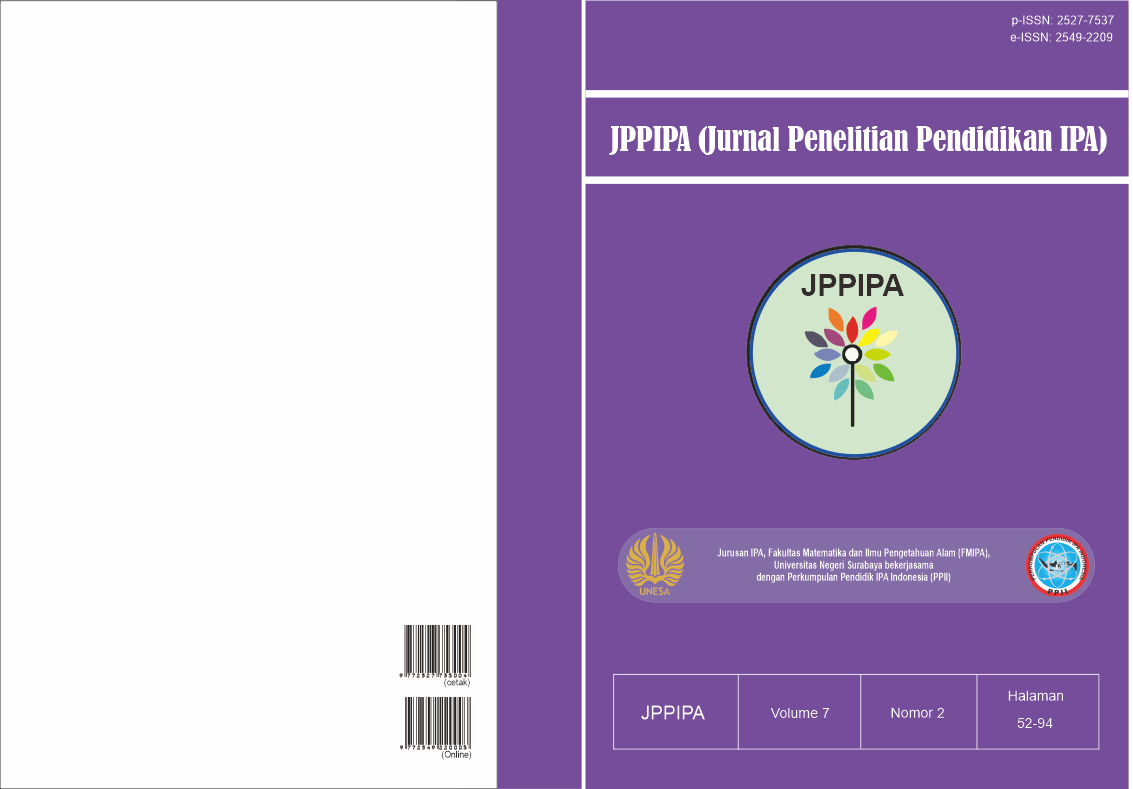EFFECTIVENESS OF DEVELOPMENT LEARNING MEDIA USING ELECTROCARDIOGRAMS (ECG) IN ELECTRICITY AND MAGNETIC LECTURES
DOI:
https://doi.org/10.26740/jppipa.v7n2.p67-71Keywords:
Learning media, electrocardiograms (ECG), electricity and magnetic lecturesAbstract
Learning creative media can expedite and increase the efficiency of learning to lead to goals of learning that can be achieved owing to delivering easy message technology for learning purposes. This study aims to find out the effective development of learning media using electrocardiograms (ECG) in electricity and magnetic lectures. The population of this study was used students in electricity and magnetic lectures with a total of students 20 and samples were by purposive sampling technique. Data collection techniques used were questionnaires with pre-test and post-test and conducted by statistical analysis Paired t-test. The average score of students before being taught using learning media using ECG is 6.65 and significantly increases to 8.40 after being given a learning media using ECG. The effectiveness analysis of learning media using ECG by Paired t-test showed there is a significant difference between before and after being taught using learning media compared to before learning creative lectures with results ?=0.000 < 0.05. Therefore, the development of learning creative media using ECG in electricity and magnetic lectures increasing of student knowledge which is fundamental considering utilize of ECG for possibly early detection of heart problems
References
Al BuAli, W. H., Balaha, M. H., & Al Muhaidab, N. S. J. A. I. M. (2013). Assessment of learning style in a sample of Saudi medical students. 21(2), 83.
Bernardi, P. (1996). The permeability transition pore. Control points of a cyclosporin A-sensitive mitochondrial channel involved in cell death. Biochimica et Biophysica Acta (BBA) - Bioenergetics, 1275(1), 5-9. doi:https://doi.org/10.1016/0005-2728(96)00041-2
Borgens, R. B., Vanable, J. W., Jr., & Jaffe, L. F. (1979). Bioelectricity and Regeneration. BioScience, 29(8), 468-474. doi:10.2307/1307539
Budiyanto, M., Yasin, M., & Suhariningsih, S. J. J. P. P. I. (2018). Pengembangan Media Pembelajaran Optik Menggunakan Sensor Serat Optik Bundle Untuk Menentukan Konsentrasi Kolesterol. 3(1), 39-44.
Geck, P., Pietrzyk, C., Burckhardt, B. C., Pfeifferl, B., & Heinz, E. (1980). Electrically silent cotransport of Na+, K+ and Cl? in ehrlich cells. Biochimica et Biophysica Acta (BBA) - Biomembranes, 600(2), 432-447. doi:https://doi.org/10.1016/0005-2736(80)90446-0
Goldman, B. J. e.-J. o. S. M. (2017). The cognitive differences between men and women.
Hulsmans, M., Clauss, S., Xiao, L., Aguirre, A. D., King, K. R., Hanley, A., Nahrendorf, M. (2017). Macrophages Facilitate Electrical Conduction in the Heart. Cell, 169(3), 510-522.e520. doi:10.1016/j.cell.2017.03.050
Jones, G. S., VanDyke, K., & Castranova, V. (1981). Transmembrane potential changes associated with superoxide release from human granulocytes. Journal of Cellular Physiology, 106(1), 75-83. doi:https://doi.org/10.1002/jcp.1041060109
Kallen, R. G., Cohen, S. A., & Barchi, R. L. (1993). Structure, function and expression of voltage-dependent sodium channels. Molecular Neurobiology, 7(3), 383-428. doi:10.1007/BF02769184
Lemasters, J. J., Nieminen, A.-L., Qian, T., Trost, L. C., Elmore, S. P., Nishimura, Y., Herman, B. (1998). The mitochondrial permeability transition in cell death: a common mechanism in necrosis, apoptosis and autophagy. Biochimica et Biophysica Acta (BBA) - Bioenergetics, 1366(1), 177-196. doi:https://doi.org/10.1016/S0005-2728(98)00112-1
McCaig, C. D., Rajnicek, A. M., Song, B., & Zhao, M. (2005). Controlling Cell Behavior Electrically: Current Views and Future Potential. Physiological Reviews, 85(3), 943-978. doi:10.1152/physrev.00020.2004
Oresko, J. J., Jin, Z., Cheng, J., Huang, S., Sun, Y., Duschl, H., & Cheng, A. C. (2010). A Wearable Smartphone-Based Platform for Real-Time Cardiovascular Disease Detection Via Electrocardiogram Processing. IEEE Transactions on Information Technology in Biomedicine, 14(3), 734-740. doi:10.1109/TITB.2010.2047865
Piccolino, M. (1998). Animal electricity and the birth of electrophysiology: the legacy of Luigi Galvani. Brain Research Bulletin, 46(5), 381-407. doi:https://doi.org/10.1016/S0361-9230(98)00026-4
Pratiwi, D. J. J. F. (2014). Gaya belajar dominan pada siswa berprestasi dalam kegiatan siswa yang memiliki gaya belajar di SD Negeri 2 Gombong tahun ajaran 2013/2014. 7(3), 1-20.
Sefton-Green, J., & Soep, E. (2007). Creative Media Cultures: Making and Learning Beyond the School. In L. Bresler (Ed.), International Handbook of Research in Arts Education (pp. 835-856). Dordrecht: Springer Netherlands.
Widiyatmoko, A., & Pamelasari, S. J. J. P. I. I. (2012). Pembelajaran berbasis proyek untuk mengembangkan alat peraga IPA dengan memanfaatkan bahan bekas pakai. 1(1).
Zamzami, N., Marchetti, P., Castedo, M., Decaudin, D., Macho, A., Hirsch, T., Kroemer, G. (1995). Sequential reduction of mitochondrial transmembrane potential and generation of reactive oxygen species in early programmed cell death. Journal of Experimental Medicine, 182(2), 367-377. doi:10.1084/jem.182.2.367
Downloads
Published
How to Cite
Issue
Section
 Abstract views: 308
,
Abstract views: 308
, PDF Downloads: 284
PDF Downloads: 284












